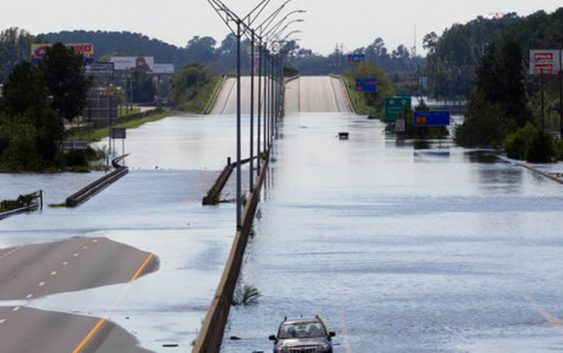- National memorial to honor NC firefighter who died on duty during Hurricane Helene
- Gov. Josh Stein extends State of Emergency for western NC wildfires
- Governor Stein extends state of emergency for NC wildfire threat
- Governor Stein extends emergency in 34 NC counties amid wildfire threat
- Texans can buy emergency preparation supplies tax-free April 26-28 ahead of severe weather season
Florence flooding puts dams, many high hazard, to the test

Devastating flooding in North Carolina in the aftermath of Hurricane Florence has raised concerns about whether dams across the state, some of them already in poor condition, will be able to hold up under the strain.
State officials have been monitoring dam safety in cooperation with local authorities and say there has been at least one dam breach so far, with no homes affected. But there have been several other locations of concern and false alarms about dam failures that have caused panic.
According to data submitted to the National Inventory of Dams for this year’s deadline and obtained by The Associated Press, the state has 1,445 dams rated high hazard out of about 5,700 dams total, ranging from large federally owned ones to small private ones. That hazard classification does not indicate the likelihood of failure — just that any failure would be likely to cause the loss of one or more human lives.
Of those high-hazard dams, 185 had conditions of poor or unsatisfactory during recent inspections, the data show. And many of those dams were in areas that have been inundated with water.
Ahead of the storm, workers with North Carolina’s Dam Safety Program identified vulnerable structures, contacted dam owners and operators to call attention to the threat and asked them to consider lowering impoundment water levels to temporarily increase storage capacity prior, Bridget Munger, a spokeswoman for the state Department of Environmental Quality said.
Dam safety personnel have also been deployed to the state Emergency Operations Center since before the storm, Munger added.
State Emergency Management Director Mike Sprayberry said Monday that there had been one dam breach in Brunswick County. He said no homes were affected in the inundation area.
On Sunday night, an Associated Press reporter was with a U.S. Army swift-water rescue team in Fayetteville when a call came over the radio about a dam failure in Pinehurst, which turned out to be a false alarm. Then another call came in reporting another dam breach.
Soldiers who had been resting on cots starting donning boots, helmets and life vests, and a team deployed toward a nearby fire department. About halfway there, the call was canceled — another false alarm.
A Facebook post claiming a dam in Hope Mills, a suburb of Fayetteville, had failed caused trouble there Sunday night, Mayor Jackie Warner said.
“It created a panic because people thought the dam had broken, and they didn’t know which way the water would go,” she said. Residents started calling asking if they needed to leave their homes, she said.
The dam held up just fine.
Rumors also spread Sunday night in nearby Hoke County about a dam break. Mandatory evacuations were ordered because of flooding at a lake, but the dam wasn’t breached, emergency management coordinator Andrew Jacobs said. The evacuation order was lifted Monday afternoon.
In McLaughlin Lakes, a subdivision immediately next to the lake, most declined to evacuate.
“It was an overreaction, don’t you think?” Jeff Konopka asked his neighbors.
“Very much so,” said Kim Santiago, who has lived beside the lake for 24 years and has seen the dam overflow in numerous storms.
Two of North Carolina’s high-hazard dams are at Duke Energy’s Weatherspoon Plant in Robeson County, an area that has been swamped with water.
One is at a cooling pond and the other at a coal ash pond. The dam at the coal ash pond was found to be in poor condition during an inspection last year, according to the data.
Both structures were performing well and no problems were expected, Duke spokeswoman Paige Sheehan said Monday.
Catastrophic dam failures are infrequent, and age is a leading indicator of dam failure, with the exception of seismic or weather events, a 2008 Congressional Research Service report found.
The American Society of Civil Engineers gave a “D” grade to the state of the country’s dams in a 2017 report, noting the average age of the dams is 56 years old. The ASCE estimated there are more than 2,000 “deficient high-hazard” dams lacking investment in repairs and upgrades.
Mark Ogden, a technical specialist with the Association of State Dam Safety Officials, said states have made significant strides in improving dam safety in recent years. But he said rising numbers of people living downstream of old dams, new dam safety technologies and other factors mean lots of upgrades are needed.
“In general, dam safety has improved tremendously over the years but there’s still a long way to go,” Ogden said.